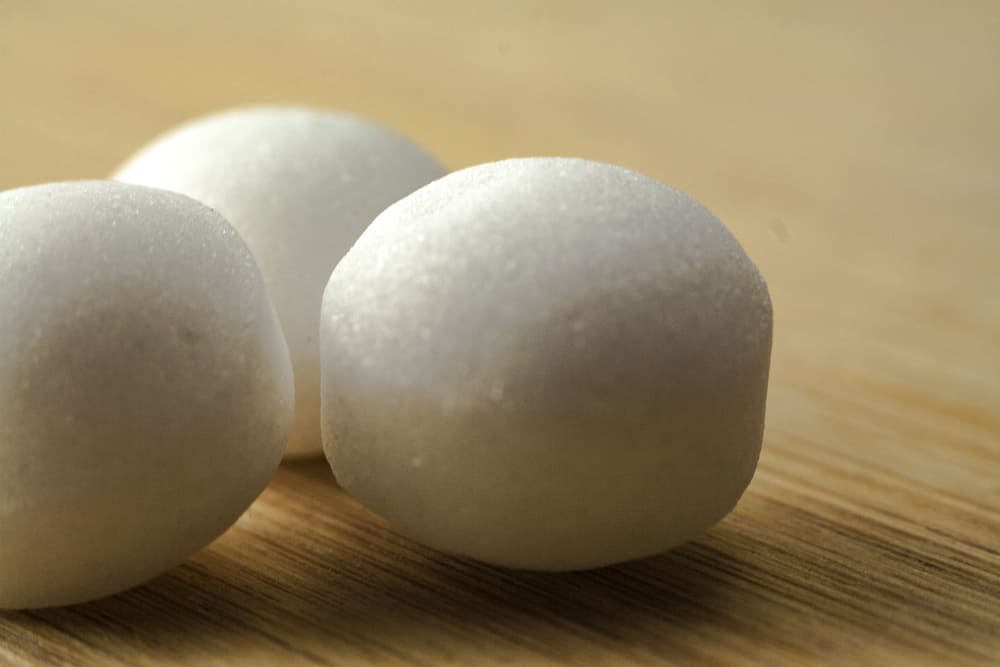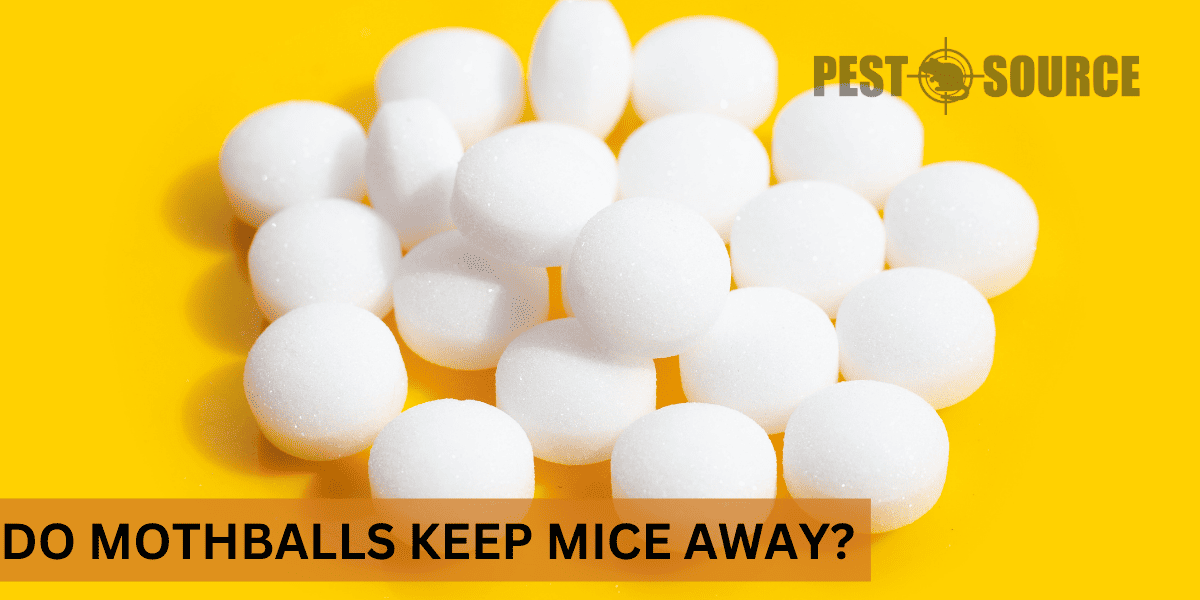Mothballs have limited effectiveness in repelling mice and can be hazardous to humans and pets. This article examines the use of mothballs for mouse control and why alternative methods may be safer and more effective.
POINTS
- Mothballs, made either from naphthalene or paradichlorobenzene, are traditionally used to protect clothes from moths. The strong odor they emit when they sublimate is believed to repel mice; however, their effectiveness as a rodent deterrent is questionable.
- Mothballs may repel mice temporarily if used in small, enclosed areas where the fumes can build up. But in open areas or larger spaces where the fumes quickly dissipate, mothballs aren’t very effective against rodents.
- Mothballs pose several health hazards, especially if ingested accidentally by children or pets. Even for adults, long-term exposure can lead to health issues like headaches, nausea, and more serious conditions like kidney and liver damage.
- The use of mothballs outdoors can contaminate soil, water, and plants, posing risks not only to the immediate environment but also potentially to the local ecosystem. They’re also flammable, thereby presenting a fire hazard.
- Instead of mothballs, safer and more effective ways of preventing and eliminating mouse infestations include: sealing potential entry points for rodents, maintaining clean living spaces, using a variety of traps, and hiring professional pest control services.
Understanding Mothballs and Their Traditional Uses
What are mothballs, and what is their primary purpose?

Mothballs are small white pellets renowned for their insecticide properties. Traditionally, mothballs have been used to protect clothing from destructive insects like clothes moths. They are placed in wardrobes, storage boxes, or any place where clothes and fabric are stored.
How do mothballs work?
The functionality of mothballs leans on their ability to transfigure from solid to a gas, a process known as sublimation. When mothballs sublimate, they release fumes containing certain pesticides. Ideally, to work effectively, mothballs should be confined in an airtight container where the potent gas builds up and kills the insects. This is why, to derive optimal benefit, they are often placed in storage boxes or drawers where the concentration of the vaporous pesticide remains high.
The Chemical Makeup of Mothballs and Its Intended Effectiveness
What chemicals do mothballs contain, and how are they toxic?
Mothballs are manufactured using either naphthalene or paradichlorobenzene, both of which are volatile pesticides. These chemicals, once inhaled or ingested, pose potential health risks to humans and pets. The resultant toxicity serves as the primary deterrent mechanism, not only for moths but also for other pests.
How are these chemicals supposed to repel or kill pests?
The two chemicals in mothballs – naphthalene and paradichlorobenzene – transform into toxic gases when exposed to air. These gases then fill the space they are in, creating an inhospitable environment for pests. It’s this heavy pesticide-laden air that mice and other pests find repulsive. The intended effect is for the mice to vacate the area once the concentration of the fumes becomes sufficiently high.
The Repellent Properties of Mothballs Against Rodents
Do mice hate the smell of mothballs?
Yes, mice do react negatively to the strong smell of mothballs. As with most rodents, mice rely heavily on their sense of smell, which is highly sensitive. Therefore, the strong, pungent odor disturbs them, encouraging a departure from areas where mothballs have been placed.
Do mothballs keep mice away?

Despite the prevalent belief that mothballs act as a deterrent for mice, the reality is somewhat different. Mothballs may repel mice in an enclosed, small, high concentration situation. However, used in the open, or in larger areas where ventilation dilutes the fumes quickly, the effectiveness of mothballs as a mouse-deterrent is highly questionable.
Do mothballs keep rodents away?
Just like with mice, mothballs are not completely useless in repelling other rodent pests like rats. Of course, it often depends on the conditions under which they are used. Rodents are smart enough to identify potential threats, and can bypass mothballs by finding alternate routes, thus making mothball usage less effective.
How do mothballs work as a deterrent for mice and rats?
When mothballs sublimate, the toxic fumes they release create an inhospitable environment for mice and rats. Exposure to the pungent odor triggers an instinctive threat response in these rodents, which then motivates them to avoid areas where mothballs have been placed.
How do the behaviors of mice and rats change in the presence of mothballs?
The primary behavioral change in mice and rats exposed to mothballs is avoidance. They’ll most likely seek out alternative routes or find different nesting grounds rather than tolerate the strong scent of the mothballs.
Efficacy of Mothballs as a Rodent Repellent
How effective are mothballs in repelling mice and rats specifically?
Extensive use of mothballs to deter rodents like mice and rats turned out to be less effective than anticipated. While it’s not unusual for a mouse to turn away from the strong scent of a mothball, long-term deterrence is commonly unsuccessful.
Do mice like mothballs?
On the contrary, mice significantly dislike mothballs due to the pervasive, strong smell that comes from the toxic chemicals they contain. However, disdain for the smell doesn’t necessarily translate into efficient pest control.
Are rodents such as mice and rats unaffected by the presence of mothballs?
The common consensus among experts argues that mothballs are ineffective rodent deterrents. Mice and rats may display an initial aversion to the strong smell, but the fumes are not potent enough to keep these pests away permanently or to eliminate them from your premises.
Are Mothballs Safe and Effective Against Mice?
What are the potential dangers of using mothballs to repel mice for humans and pets?
While mothballs can serve as a temporary repellant for rodents, they present several risks to humans and pets. Children and pets can mistake mothballs for candy or food, leading to accidental ingestion which can result in serious health risks like anemia, neurological damage, kidney problems, and in severe cases, can be life-threatening.
Even for adults, prolonged exposure to the strong fumes released by mothballs can lead to headaches, nausea, respiratory distress, and even kidney and liver damage in the long run. On top of that, since mothballs are flammable, they can pose a significant fire hazard if not stored properly.
How do mothballs pose environmental and health risks when used outdoors?
Mothballs used outdoors can affect soil, water, and plants becoming an environmental contaminant. As they sublimate, harmful chemicals are released into the air, which can then seep into the soil. These chemicals could then potentially enter the water system, posing a risk to aquatic life.
Furthermore, due to their volatile nature, mothballs can dissolve in rain or be blown away by wind, potentially affecting wildlife that might ingest them accidentally or inhale the fumes, thereby posing a serious risk to the local ecosystem.
Legal and Safety Regulations Surrounding Mothball Usage
What are the regulatory positions on using mothballs for purposes other than repelling moths?
Legal positions on using mothballs vary by country. In the United States, the Environmental Protection Agency (EPA) requires that mothballs be used strictly following their on-label instructions. Any usage outside of these prescribed instructions is considered illegal. Hence, using mothballs to repel rodents, a use not usually mentioned on the product label, can be considered illegal under EPA regulations.
Why is the use of mothballs for repelling rodents not recommended by health and safety authorities?
Health and safety authorities discourage the use of mothballs as a rodent repellant due to its limited effectiveness and associated health risks. Mothballs are designed to kill pests in closed, controlled environments, and their fumes are harmful if inhaled or ingested by humans or pets. Using them in open spaces, or where humans and pets frequent, exposes these susceptible individuals to unnecessary health risks.
Practical Considerations and Alternatives in Rodent Control
Is it practical to use mothballs to get rid of mice?
Given mothballs’ limited effectiveness in repelling rodents and the potential health hazards they pose, they aren’t a practical solution for tackling a mouse problem. A critical aspect of successful rodent control is understanding rodent behavior. Mice are highly adaptable and can quickly learn to avoid things that indicate danger, such as the smell of mothballs. Hence, while mothballs may offer short-term relief from mice, they are unlikely to provide an effective long-term solution.
What alternative methods exist for safely repelling or getting rid of mice and rats?
A combination of preventative measures and professional pest control solutions are generally the most effective approach to getting rid of mice. Here are some alternatives to using mothballs:
- Sealing entry points: Mice can come through tiny holes or gaps. To keep them out, seal all potential entry points using steel wool or caulk.
- Good yard and housekeeping: Keeping your living spaces clean and organized can minimize the chances of attracting rodents.
- Use of rodent traps: A variety of traps can effectively catch mice and rats. However, ensure to regularly inspect and empty traps to avoid dead mice attracting other pests.
- Professional pest control companies: When facing a significant rodent problem, professional pest management services are the most effective. They use safe and efficient methods to eliminate the pests and provide guidance on preventative measures.



